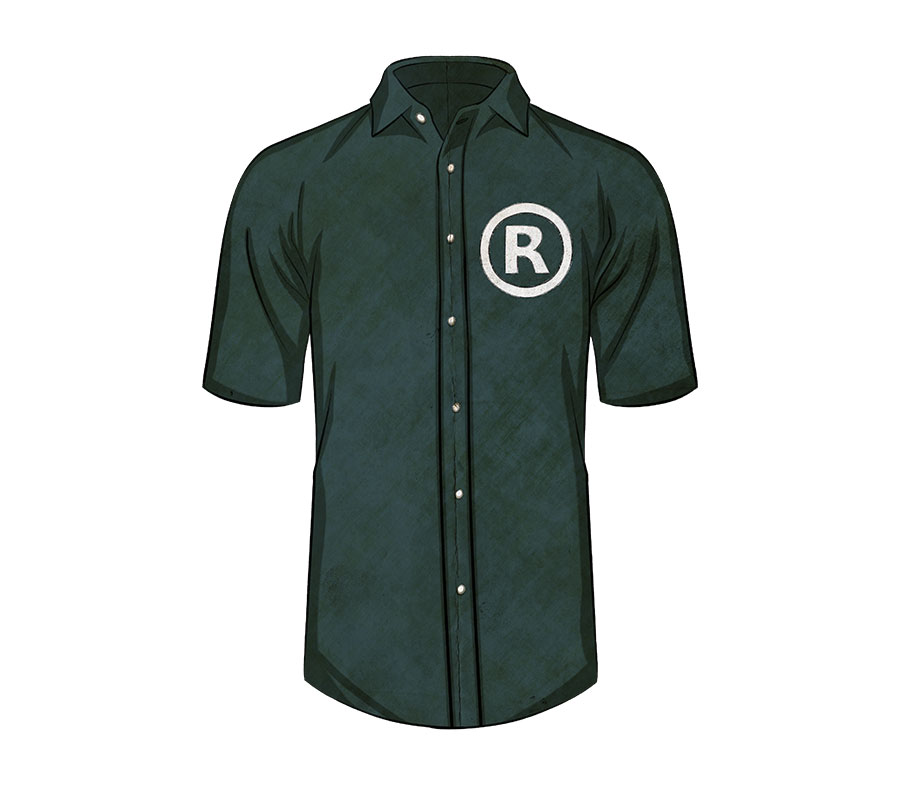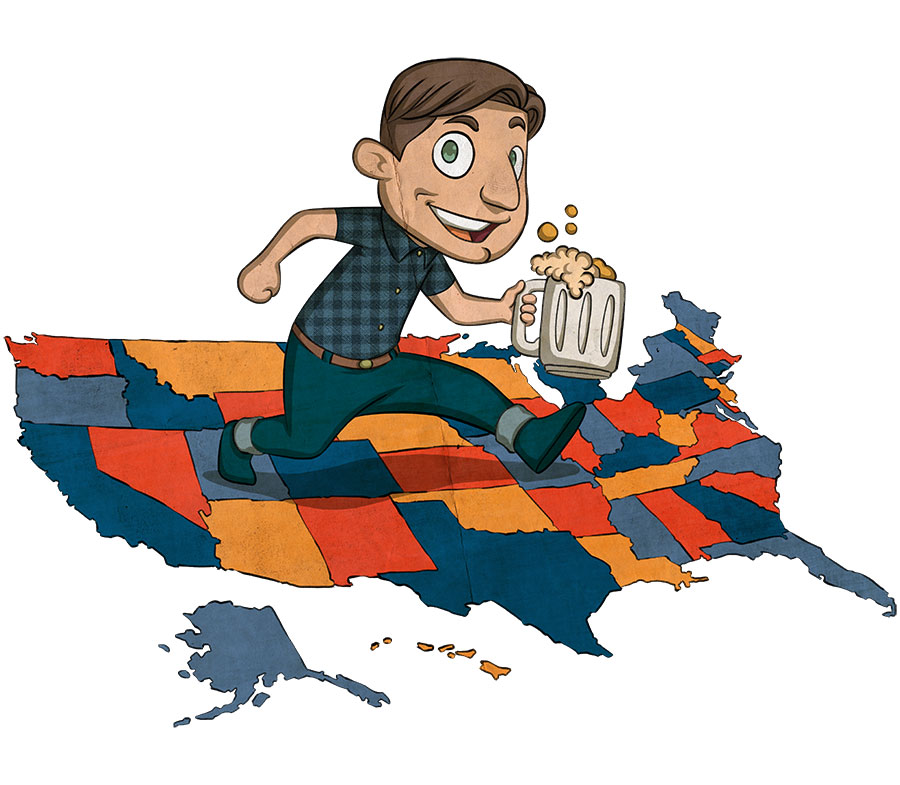Clothing Trademarks - is your trademark a "brand identifier" or just a decoration?
Trademarks are used to identify products. A trademark tells you about the product (usually who made the product and a certain level of quality). In order to file a trademark for clothing, you have to use your trademark to identify the clothing as belonging to the trademarked brand and not as a decoration. Trademarks that are only decorative do not identify and distinguish goods and do not act as a trademark.
A Ford logo can be used to identify a truck. But the same logo on a t-shirt does not identify a certain brand of clothing (for example, quality, country of origin, etc.). Instead, this logo is being used as a decoration to appeal to people that like the Ford brand.
The size, location, and dominance of the proposed trademark are used to determine whether the mark is a trademark or just a decoration.
While no bright-line rule exists for making a determination whether or not a mark will qualify as a trademark, generally a small, neat, and discrete word or design feature is likely to create the commercial impression of a trademark.
The best bet is to put your trademark on a tag on the clothing itself or on a string connected label.
Trademarks, Beer and State Lines
Trademarks, Beer and State Lines
I don’t distribute out of state. Can I still trademark my beer names?
The short answer is YES!
The Lanham Act (also known as the Trademark Act of 1946) is the federal statute that governs trademarks. Generally, the Lanham Act requires that a mark is used in interstate commerce before it may be registered as a federal trademark.
Fortunately, interstate commerce is broadly defined.
Traditionally, interstate commerce has been focused on whether or not goods have physically crossed state lines. Due to the nature of modern commerce, travel, and the expanding reach of the internet, the lines for what is truly “local” has changed over the years.
“Use in Commerce” Within a State
Adidas (the shoe and apparel company) tried to trademark “ADIZERO” for athletic apparel (fun fact-one of the founding brothers of Adidas broke off and formed the shoe company Puma). The Trademark Office blocked this trademark because of a likelihood of confusion with the trademark “ADD A ZERO,” which was a clothing trademark owned by a church in Illinois for its fundraising campaign to encourage its congregants to add a zero to their donations (as in don’t give $10, give $100).
Adidas argued that the church’s marks were not in interstate commerce. The Illinois church defended the alleged non-use in interstate commerce argument by offering evidence that it had sold two hats bearing the contested marks to a parishioner who resided across state lines in Wisconsin. The sale occurred within Illinois, so the church did not rely on a sale made to a customer located across state lines at the time of the purchase. Adidas argued that the sale of two hats were “de minimis,” meaning too trivial or minor to merit consideration for interstate commerce. Adidas won at the trademark court and the decision was appealed.
The Federal Circuit on appeal clarified the broad protection of the Lanham Act and reversed the trademark court holding. The Federal Circuit stated that the Lanham Act defines interstate commerce as all commerce which may lawfully be regulated by Congress.
The Federal Circuit held on appeal that the church’s sale of two hats showed that the marks were used in interstate commerce for Lanham Act purposes. The Federal Circuit Court held that the church was not required to present evidence that its sale of hats actually affected interstate commerce, or even to show that the hats were destined to cross state lines. Rather, the church merely needed to show that its sale activity, even if just local, fell “within a category of conduct that, in the aggregate” could exert a substantial effect on interstate commerce.
Say That Again Please (In English)
Breweries make beer. Beer is offered for sale. Out of state people may purchase said beer at the brewery, restaurants or other locales. These purchases in the aggregate can affect interstate commerce.
Helpful Tips
Because the law (or the courts’ interpretation of the law) can change, here are some practical tips to support that you have interstate commerce beer:
- When you release a new beer, make sure to get it on the worldwide web (whether through your own website or through the various social media channels).
- Encourage your guests to review your beer on the various beer review websites (odds are good you will have plenty of out of state).
Cheers!
Trademark Costs for Beer and Breweries
Trademark Costs for Beer and Breweries
So you’ve decided to make the leap and apply for a trademark for your beer or your brewery.
You’ve settled on a word, phrase or design that is suitable for trademark, done your clearance search to make sure nobody else is using that mark, and are ready to apply. You go to the United States Patent and Trademark Office (“USPTO”) and start to look at the long list of fees. What now?
The cost to file a trademark online.
The USPTO has a long fee schedule for various types of filings. For new applications, you can file it online using the USPTO’s application website, using the TEAS Plus application, which is simple, quick, and gets your application filed immediately. For a TEAS Plus application the fee is $350 per international class.
Now for the fine print:
The application fee in the U.S. is per international class. What is an international class?
It is a schedule of numbered classes of goods and services in which you classify a trademark. For example, beer would fall into Class 032 for beverages. But you may wish to register a trademark in more than one international class. For example, a brewery may want to register its brewery trademark for beer (Class 032), taproom services (Class 043), and maybe for merchandise, like T-shirts (Class 025). When you file an application for a trademark in multiple international classes, you have to pay the fee for each class applied for. So the brewery example above filed using TEAS Plus would have a filing fee of $1050 ($350+$350+$350). That is only the filing fee charged by the USPTO; it does not include attorney’s fees for any assistance in filing by your attorney, or other costs.
In addition to the initial filing of an application for the trademark, you will have to make periodic filings to maintain your trademark. After six years, you must file a renewal filing to demonstrate your continued use of the mark, for example. Or if you filed an intent-to-use application (where you file an application for a trademark before you have actual proceeded to use the mark in commerce), you will have to file a statement of use. These filings vary between $125 and $650.
Other trademark costs you should anticipate are costs to respond to any refusal or opposition to your trademark during the application phase. Your trademark application is examined by an Examiner at the USPTO, who may issue an Office Action stating certain grounds for why your trademark should not be published. You or your attorney will have to respond to such Office Actions, which come with your attorney’s fees and costs. Also, even if your mark is published, another person may oppose the registration and file what is called an opposition (before your mark is registered) or a cancellation (after your mark is registered). Responding to these filings (or if need be, filing your own oppositions and cancellations) come with filing fees of $600 and attorney’s fees and costs, sometimes hefty sums.
Using Names in Beer or Brewery Trademarks
Using Names in Beer or Brewery Trademarks
You have a great idea for a beer concept and want to have a catchy name for the beer or brewery, so you decide to use your old uncle Bob’s name. Can you trademark Bob’s name for your beer or the brewery? It depends.
Can You Trademark a Name?
One of the grounds used by the USPTO for refusal to register a mark is Section 2(c): “Consists of or comprises a name, portrait, or signature identifying a particular living individual except by his written consent, or the name, signature, or portrait of a deceased President of the United States during the life of his widow, if any, except by the written consent of the widow.” So, no President Obama Porter, thank you very much. And no use of Bob’s name, if alive, without his written consent filed with the USPTO.
This is also covered in Section 2(e)(4) under descriptive marks for “merely surnames.” Why the prohibition on “mere surnames” serving as marks? Mostly because it is merely descriptive. “John’s Ale” is as merely descriptive as saying “this is my ale.”
There are five elements used in analyzing whether a mark is “primarily merely a surname” and might be refused as merely descriptive:
- whether the surname is rare (see TMEP §1211.01(a)(v))
- whether the term is the surname of anyone connected with the applicant (see TMEP §1211.02(b)(iv))
- whether the term has any recognized meaning other than as a surname (see TMEP §§1211.01(a)–1211.01(a)(vii))
- whether it has the “structure and pronunciation” of a surname (see TMEP §1211.01(a)(vi))
- whether the stylization of lettering is distinctive enough to create a separate commercial impression (see TMEP §1211.01(b)(ii)).
Where the mark is in standard characters, it is unnecessary to consider the fifth factor. This determination is made from the point of view of American buyers familiar with the foreign language. For example, FIORE – Italian for flower – was held to not be primarily a surname since American consumers would not generally recognize the word in its English translation. So, the more obscure the foreign surname, the more likely the name may pass muster and be registered.
Another consideration in using a name of a person, even a non-living person, is whether the use would impinge on any rights of publicity in the name of a person. Many states passed “celebrity name” rights statutes in the post-World War Two era, which protect the rights of the descendants of famous persons to the use of their ancestor’s names for publicity purposes. Most of those statutes, however, have a time limitation. For example, Oklahoma’s post-mortem celebrity right of publicity statute does not apply to persons who died before January 1, 1936. There are also common-law rights in persons’ names and personas, which vary widely by state.
It would be advisable to always consult with an attorney before attempting to use a name of a person- living or dead – for a trademark for your brewery and beers.
Trademark, Copyright or Patent - Which is right for your business?
Trademark, Copyright or Patent – Which is right for your business?
There is often a great deal of confusion over whether a trademark, copyright or patent is the appropriate intellectual property solution. Whereas copyrights and patents protect original creative works, trademarks protect business branding and good will in the marketplace.
Copyrights
Copyrights are granted under federal law for original creative works in just about any medium imaginable – writings like books, music, even statues.
Patents
Patents are protections under federal law for original functional creative works, i.e, inventions.
Patents protect things like new kinds of machines, chemical and other processes, and new ways of doing things in non-obvious ways.
Both patent and copyright therefore are federal protections for new, original, creative works and protect the author’s or inventor’s rights to use, distribute and profit from the creative work.
Trademarks
Trademarks, however, are a different animal. As the U.S. Supreme Court has noted in the Trademark Cases, “neither originality, invention, discovery, science, nor art is in any way essential” to trademark rights. Trademarks do not have to be new, creative, or original in any way, other than not having someone else already using it. Trademarks can be as boring and unoriginal as “ACME Tool Company.”
Instead, trademarks protect the words or symbols used by business and individuals in distinguishing their goods and services sold in commerce from the goods and services sold by others. Trademarks have been considered as a device to protect the goodwill or reputation of businesses who have spent time and money in building their brand recognition with consumers in the marketplace. Trademark is not a property right in the word – one does not “own” the words or symbols constituting the mark to the exclusion of others. Trademark only protects the registered owner from others using the mark on similar goods or services, impinging on the goodwill and reputation of the registered owner and causing confusion in the marketplace. This distinction is reflected in the definition of trademark in federal law:
- “The term “trademark” includes any word, name, symbol, or device, or any combination thereof… used by a person… to identify and distinguish his or her goods, including a unique product, from those manufactured or sold by others and to indicate the source of the goods, even if that source is unknown.
15 U.S.C. § 1127.
*Trademarks are a valuable component of every business marketing plan. If you have any doubts about whether you need a trademark, copyright, or patent, the attorneys at Drumm Law can be of assistance.*





